英语句法结构精粹
英语句法知识
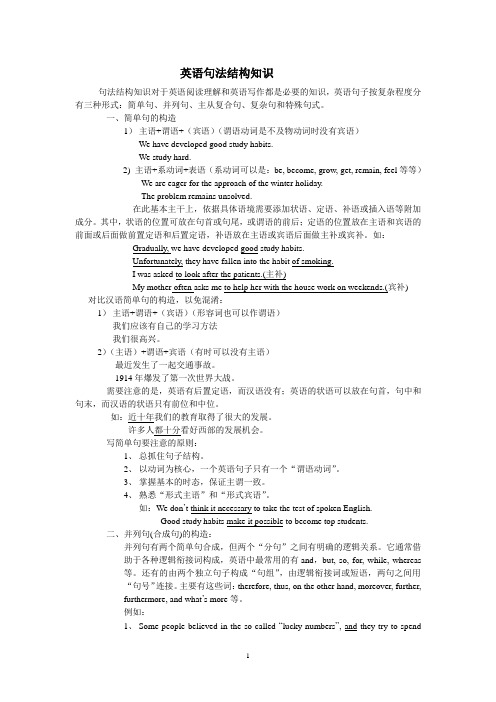
英语句法结构知识句法结构知识对于英语阅读理解和英语写作都是必要的知识,英语句子按复杂程度分有三种形式:简单句、并列句、主从复合句、复杂句和特殊句式。
一、简单句的构造1)主语+谓语+(宾语)(谓语动词是不及物动词时没有宾语)We have developed good study habits.We study hard.2) 主语+系动词+表语(系动词可以是:be, become, grow, get, remain, feel等等)We are eager for the approach of the winter holiday.The problem remains unsolved.在此基本主干上,依据具体语境需要添加状语、定语、补语或插入语等附加成分。
其中,状语的位置可放在句首或句尾,或谓语的前后;定语的位置放在主语和宾语的前面或后面做前置定语和后置定语,补语放在主语或宾语后面做主补或宾补。
如:Gradually, we have developed good study habits.Unfortunately, they have fallen into the habit of smoking.I was asked to look after the patients.(主补)My mother often asks me to help her with the house work on weekends.(宾补) 对比汉语简单句的构造,以免混淆:1)主语+谓语+(宾语)(形容词也可以作谓语)我们应该有自己的学习方法我们很高兴。
2)(主语)+谓语+宾语(有时可以没有主语)最近发生了一起交通事故。
1914年爆发了第一次世界大战。
需要注意的是,英语有后置定语,而汉语没有;英语的状语可以放在句首,句中和句末,而汉语的状语只有前位和中位。
如:近十年我们的教育取得了很大的发展。
许多人都十分看好西部的发展机会。
英语五种句子结构

英语五种句子结构精选英文英语五种句子结构:英语五种句子结构解析1. 简单句(Simple Sentence): 这是最基本的句子结构,只包含一个主语和一个谓语。
例如:She sings beautifully. (她唱得很美。
)2. 并列句(Compound Sentence): 由两个或更多的简单句通过并列连词(如and, but, or等)连接而成。
例如:She sings beautifully, but he dances gracefully. (她唱得很美,但他跳得很优雅。
)3. 复合句(Complex Sentence): 包含一个主句和一个或多个从句。
从句不能独立成句,需要依赖主句来表达完整的意思。
例如:I know that she is coming tomorrow. (我知道她明天要来。
)4. 并列复合句(Compound-Complex Sentence): 这是由并列句和复合句结合而成的句子。
它包含两个或多个主句,其中至少有一个主句包含一个或多个从句。
例如:She sings beautifully, and I know that she practices every day. (她唱得很美,我知道她每天都练习。
)5. 省略句(Ellipsis): 这是一种不完全的句子,省略了某些词或词组,但在上下文中仍然能够理解其意义。
例如:Is she coming? (Yes,) She is. (她会来吗?是的,她会来。
)这五种句子结构在英语中非常常见,掌握它们对于理解和运用英语句子非常有帮助。
中文对照翻译:Analysis of Five Sentence Structures in English1. Simple Sentence: This is the most basic sentence structure that only contains onesubject and one predicate. For example: She sings beautifully (She sings beautifully.)2. Compound Sentence: It is composed of two or more simple sentences connected by coordinate conjunctions (such as and, but, or). For example: She sings beautifully, but she dances gracefully (She sings beautifully, but he dances gracefully.)3. Complex Sentence: Contains a main clause and one or more subordinate clauses. A subordinate clause cannot form an independent sentence and needs to rely on the main clause to express the complete meaning. For example: I know that she is coming tomorrow (I know she will come tomorrow.)4. Compound Compound Sentence: This is a sentence formed by combining a compound sentence with a compound sentence. It contains two or more main clauses, with at least one main clause containing one or more subordinate clauses. For example: She sings beautifully, and I know that she practices every day (She sings beautifully, and I know she practices every day.)5. Ellipsis: This is an incomplete sentence that omits certain words or phrases, but its meaning can still be understood in the context. For example: Is she coming? (Yes, she is.) These five sentence structures are very common in English, and mastering them is very helpful for understanding and applying English sentences.。
分析英语句子结构
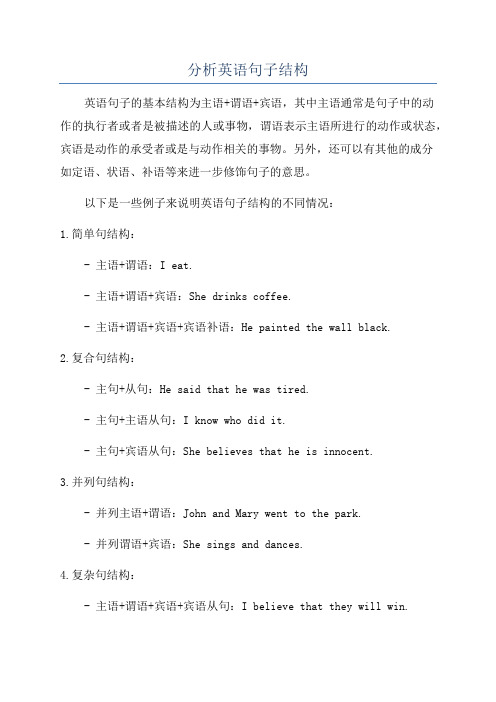
分析英语句子结构英语句子的基本结构为主语+谓语+宾语,其中主语通常是句子中的动作的执行者或者是被描述的人或事物,谓语表示主语所进行的动作或状态,宾语是动作的承受者或是与动作相关的事物。
另外,还可以有其他的成分如定语、状语、补语等来进一步修饰句子的意思。
以下是一些例子来说明英语句子结构的不同情况:1.简单句结构:- 主语+谓语:I eat.- 主语+谓语+宾语:She drinks coffee.- 主语+谓语+宾语+宾语补语:He painted the wall black.2.复合句结构:- 主句+从句:He said that he was tired.- 主句+主语从句:I know who did it.- 主句+宾语从句:She believes that he is innocent.3.并列句结构:- 并列主语+谓语:John and Mary went to the park.- 并列谓语+宾语:She sings and dances.4.复杂句结构:- 主语+谓语+宾语+宾语从句:I believe that they will win.- 主语+谓语+宾语+状语从句:She went to the store because she needed groceries.- 主语+谓语+宾语+定语从句:The book that I bought yesterday is very interesting.需要注意的是,句子结构可以根据需要进行变换和调整,同时可以加入更多的修饰成分来使句子更加丰富和清晰。
所以,英语句子结构是灵活多样的,可以通过不同的组合和方式来表达各种不同的意思。
英语句法结构介绍
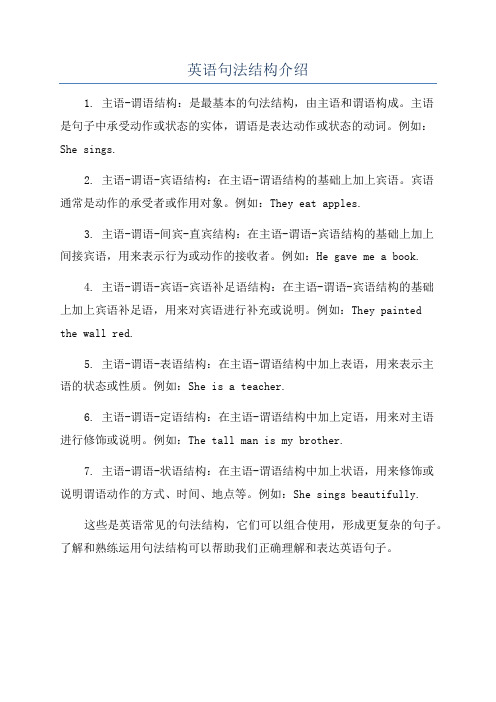
英语句法结构介绍
1. 主语-谓语结构:是最基本的句法结构,由主语和谓语构成。
主语
是句子中承受动作或状态的实体,谓语是表达动作或状态的动词。
例如:She sings.
2. 主语-谓语-宾语结构:在主语-谓语结构的基础上加上宾语。
宾语
通常是动作的承受者或作用对象。
例如:They eat apples.
3. 主语-谓语-间宾-直宾结构:在主语-谓语-宾语结构的基础上加上
间接宾语,用来表示行为或动作的接收者。
例如:He gave me a book.
4. 主语-谓语-宾语-宾语补足语结构:在主语-谓语-宾语结构的基础
上加上宾语补足语,用来对宾语进行补充或说明。
例如:They painted
the wall red.
5. 主语-谓语-表语结构:在主语-谓语结构中加上表语,用来表示主
语的状态或性质。
例如:She is a teacher.
6. 主语-谓语-定语结构:在主语-谓语结构中加上定语,用来对主语
进行修饰或说明。
例如:The tall man is my brother.
7. 主语-谓语-状语结构:在主语-谓语结构中加上状语,用来修饰或
说明谓语动作的方式、时间、地点等。
例如:She sings beautifully.
这些是英语常见的句法结构,它们可以组合使用,形成更复杂的句子。
了解和熟练运用句法结构可以帮助我们正确理解和表达英语句子。
五种句子基本结构

五种句子基本结构句子是语言的基本单位,是构成语言的基本元素。
在英语中,句子的基本结构主要包括五种,简单句、并列句、复合句、主从复合句和倒装句。
这五种句子结构在英语写作和口语表达中起着非常重要的作用,掌握这些句子结构对于提高语言表达能力至关重要。
首先,简单句是由一个主语和一个谓语构成的句子,它表达一个完整的意思。
比如,“She sings.”这个句子就是一个简单句,主语是“She”,谓语是“sings”。
简单句结构简洁明了,常用于叙述事实、表达简单的观点或描述事物。
其次,并列句是由两个或多个简单句通过并列连词连接而成的句子。
比如,“I like reading, and she likes dancing.”这个句子就是一个并列句,通过并列连词“and”连接了两个简单句。
并列句结构多用于表达对比、并列或选择关系,可以使句子更加丰富多彩。
接下来,复合句是由一个主句和一个或多个从句构成的句子。
从句可以是名词性从句、形容词性从句或副词性从句。
比如,“He said that he would come to see me.”这个句子就是一个复合句,主句是“He said”,从句是“that he would come to see me”。
复合句结构复杂多样,常用于表达因果关系、条件关系或目的关系。
然后,主从复合句是由一个主句和一个或多个从句构成的句子,从句在句子中起着修饰或补充主句的作用。
比如,“I met afriend who is from Canada.”这个句子就是一个主从复合句,主句是“I met a friend”,从句是“who is from Canada”。
主从复合句结构灵活多变,可以使句子更加具体和生动。
最后,倒装句是将谓语动词放在主语之前的句子结构。
倒装句结构多用于强调句子中的某一部分,或者用于问句和条件句中。
比如,“Not only does he play the guitar, but he also sings.”这个句子就是一个倒装句,将谓语动词“does”放在了主语“he”的前面。
英语句子结构1

英语句子成分结构详解一、英语语句基本结构分析:(一)主谓宾结构:1、主语:可以作主语的成分有名词(如boy),主格代词(如you),数词,动词不定式,动名词等。
主语一般在句首。
注意名词单数形式常和冠词不分家!eg: The boy comes from America.He made a speech.Two and two is four.To be a teacher is my dream.Doing a research is a necessary step of covering a story.2、谓语:谓语由动词构成,是英语时态、语态变化的主角,一般在主语之后。
谓语可以是不及物动词(vi.)没有宾语,形成主谓结构,eg: We come.Many changes took place in my home town.3、宾语:宾语位于及物动词之后,一般同主语构成一样,不同的是构成宾语的代词必须是‘代词宾格’,如:me,him,them等。
除了代词宾格可以作宾语外,名词,动名词,不定式等可以作宾语。
eg:I will do it tomorrow.The boy needs a pen.I like swimming.I like to swim this afternoon.(二)主系表结构:1、主语:同‘主谓宾’结构。
2、谓语:联系动词(Link verb):be动词(am, is, are, was, were,have been);其他联系动词如:become成为,turn变成,go变和感官动词如:feel, touch, hear, see等。
其特点是联系动词与其后的表语没有动宾关系,表语多为形容词,不可能是宾语。
例:Tom is a boy.(Tom是个男孩)主语为Tom,系词为be动词的第三人称单数is,表语为a boy It sounds nice.这个听起来不错。
英语句子结构分析讲解_图文
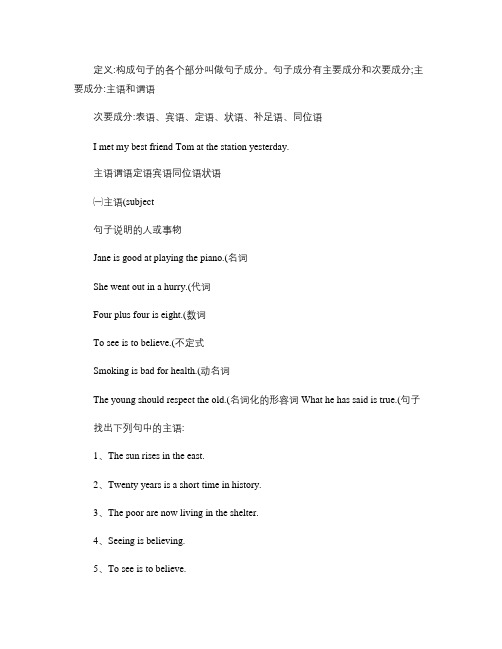
定义:构成句子的各个部分叫做句子成分。
句子成分有主要成分和次要成分;主要成分:主语和谓语次要成分:表语、宾语、定语、状语、补足语、同位语I met my best friend Tom at the station yesterday.主语谓语定语宾语同位语状语㈠主语(subject句子说明的人或事物Jane is good at playing the piano.(名词She went out in a hurry.(代词Four plus four is eight.(数词To see is to believe.(不定式Smoking is bad for health.(动名词The young should respect the old.(名词化的形容词 What he has said is true.(句子找出下列句中的主语:1、The sun rises in the east.2、Twenty years is a short time in history.3、The poor are now living in the shelter.4、Seeing is believing.5、To see is to believe.6、He likes dancing.7、What he needs is a book.8、It is very clear that the elephant is round and tall like a tree.给大家推荐一个英语微信群Empty Your Cup英语微信群是目前学习英语最有效的方法,群里都是说英语,没有半个中文,而且规则非常严格,是一个超级不错的英语学习环境,群里有好多英语超好的超牛逼的人,还有鬼佬和外国美眉。
其实坦白说,如果自己一个人学习英语太孤独,太寂寞,没有办法坚持,好几次都会半途而废。
只要你加入到那个群里以后,自己就会每天都能在群里坚持学,坚持不停地说和练,由于是付费群,群里的成员学习氛围非常强,每天的训练度都非常猛,本来很懒惰的你一下子就被感染了,不由自主地被带动起来参与操练,不好意思偷懒,别人的刻苦学习精神会不知不觉影响你,Empty Your Cup英语微信群(进群加维新 601332975可以彻底治好你的拖延症,里面学员都非常友好,总是给你不断的帮助和鼓励,让你学英语的路上重新燃起了斗志,因为每天都在运用,你的英语口语就能得到了迅猛的提升,现在可以随便给一个话题,都能用英文滔滔不绝的发表5分钟以上对这个话题的看法和观点,想提高英语口语的可以加入进来,It really works very well.加入纯英语微信群的20大特别理由1,加群可以每天拥有正能量2,加群可以彻底攻克英语口语3,加群可以不断结识高端人脉4,加群可以每天不断突破自我5,加群可以每天保持精神亢奋6,加群可以彻底改变你的命运7,加群可以每天给自己大脑充值8,加群可以让自己每天不断进步9,加群可以彻底激发你的无限潜能10,加群可以让你持续性的终身学习11,加群可以让你随时随地的学英语12,加群可以让你拥有无穷的个人魅力13,加群可以让你战胜自卑,突破自我14,加群可以借助群体的力量壮大自己15,加群可以让自己的核心竞争力不断增加16,加群可以跟着群里的口语大咖一起学习17,加群可以让你脱胎换骨变成有影响力的人18,加群可以加入成功的氛围,融入成功的环境19,加群可以和群里牛人交流分享学习经验心得20,加群可以实现内部绝密资源共享,共同进步㈡谓语说明主语的动作、状态和特征简单谓语:由动词或动词词组组成I saw the flag on the top of the hill?He looked after two orphans.复合谓语:由情态动词或助动词+动词;He can speak English well.She doesn’t seem to like dancing.找出下列句中的谓语(注:只有动词才可作谓语。
如何分析英语句子结构-图文(2024版)

① My brother hasn't done his homework. A B C D ② People all over the world speak English. A B C D ③ You must pay good attention to your pronunciation. A B C D
① D ② A ③ D ④ D
挑出下列句中的状语
7、补足语:补充说明句中的主语或者宾语的,作补足语的有:名词、形容词、介词短语、不定式和分词(短语)。如I find it interesting中的interesting.
8、同位语:把一个名词(短语)、代词或从句放在另一名词或代词后,用以说明前者的性质或情况,这样的名词或代词叫同位语。如We Chinese people ,love peace中的Chinese people是主语We的同位语.
① C ② C ③ C ④ C
挑出下列句中的宾语补足语
二、按照句子的结构来分,英语的句子有以下三种类型: 1、简单句:简单句只有一个主语(或并列主语)和一个谓语动词(或并列谓语动词)。如:My brother and I go to school at half past seven in the morning and come back home at seven in the evening.
英语语句基本结构分析

英语语句基本结构分析英语语法是针对英语语言进行研究后,系统地总结归纳出来的一系列语言规则。
英语语法的精髓在于掌握语言的使用。
下面店铺为大家带来英语语句基本结构分析,希望大家喜欢!一、英语语句基本结构分析(一)主谓宾结构:1、主语:可以作主语的成分有名词(如boy),主格代词(如you),数词,动词不定式,动名词等。
主语一般在句首。
注意名词单数形式常和冠词不分家!eg: The boy comes from America.He made a speech.Tow and tow is four.To be a teacher is my dream.Doing a research is a necessary step of covering a story.2、谓语:谓语由动词构成,是英语时态、语态变化的主角,一般在主语之后。
谓语可以是不及物动词(vi.)没有宾语,形成主谓结构,eg:We come.Many changes took place in my home town.注(以下这些词是不及物动词:表发生、出现的,如:take place,appear, happen, break out;表来、去,如:come, go 等)3、宾语:宾语位于及物动词之后,一般同主语构成一样,不同的是构成宾语的代词必须是‘代词宾格’,如:me,him,them等。
除了代词宾格可以作宾语外,名词,动名词,不定式等可以作宾语。
eg:I will do it tomorrow.The boy needs a pen.I like swimming.I like to swim this afternoon.(二)主系表结构:1、主语:同‘主谓宾’结构。
2、谓语:联系动词(Link verb):be动词(am,is,are,was,were,have been);其他联系动词如:become成为,turn变成,go变和感官动词如:feel, touch, hear, see等。
句子结构英语七大结构用法
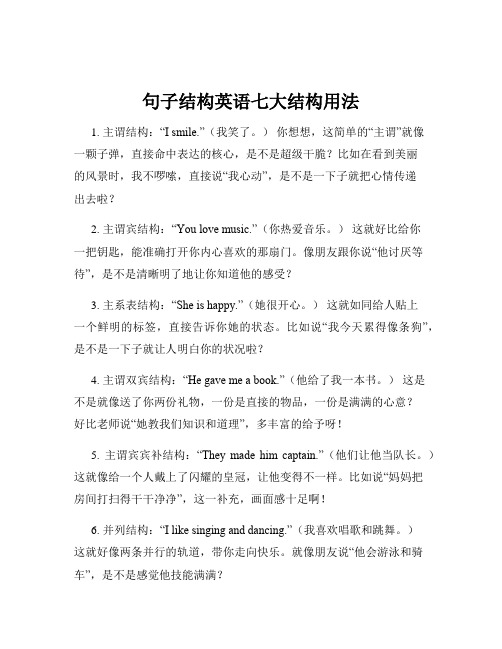
句子结构英语七大结构用法1. 主谓结构:“I smile.”(我笑了。
)你想想,这简单的“主谓”就像一颗子弹,直接命中表达的核心,是不是超级干脆?比如在看到美丽的风景时,我不啰嗦,直接说“我心动”,是不是一下子就把心情传递出去啦?2. 主谓宾结构:“You love music.”(你热爱音乐。
)这就好比给你一把钥匙,能准确打开你内心喜欢的那扇门。
像朋友跟你说“他讨厌等待”,是不是清晰明了地让你知道他的感受?3. 主系表结构:“She is happy.”(她很开心。
)这就如同给人贴上一个鲜明的标签,直接告诉你她的状态。
比如说“我今天累得像条狗”,是不是一下子就让人明白你的状况啦?4. 主谓双宾结构:“He gave me a book.”(他给了我一本书。
)这是不是就像送了你两份礼物,一份是直接的物品,一份是满满的心意?好比老师说“她教我们知识和道理”,多丰富的给予呀!5. 主谓宾宾补结构:“They made him captain.”(他们让他当队长。
)这就像给一个人戴上了闪耀的皇冠,让他变得不一样。
比如说“妈妈把房间打扫得干干净净”,这一补充,画面感十足啊!6. 并列结构:“I like singing and dancing.”(我喜欢唱歌和跳舞。
)这就好像两条并行的轨道,带你走向快乐。
就像朋友说“他会游泳和骑车”,是不是感觉他技能满满?7. 复合结构:“When I come home, my mom is cooking.”(当我回家时,我妈妈正在做饭。
)这就像一部精彩的电影,有不同的场景切换。
比如“在我睡觉的时候,爸爸还在工作”,多辛苦呀!8. 动名词结构:“Swimming is my favorite sport.”(游泳是我最喜欢的运动。
)这就像一阵风,带来活力与激情。
你看“跑步让我充满能量”,多有动力!9. 不定式结构:“To learn English well is not easy.”(学好英语不容易。
从句法结构来分析英汉互译

从句法结构来分析英汉互译
在英汉互译中,句法结构是非常重要的。
句法结构指的是语言中不同句子成分之间的关系和顺序。
掌握句法结构可以帮助我们理解和正确翻译句子。
下面我们来分析几个常见的句法结构。
1. 主谓结构
主谓结构是句子中最基本的结构。
主谓结构包含一个主语和一个谓语动词,用来表达一个事件或者状态。
在英汉互译中,主谓结构的翻译通常比较直接。
例如:
- 英文句子: He runs.
- 中文翻译: 他跑步。
2. 主谓宾结构
主谓宾结构是由一个主语、一个谓语动词和一个宾语组成的。
宾语可以是名词、代词或者动名词。
- 英文句子: 我买了一本书。
- 中文翻译: I bought a book.
4. 并列结构
并列结构是指在一个句子中,两个或多个句子或者词组具有相同的地位和功能。
在并列结构中,每个句子或者词组之间使用逗号、分号或者连词来连接。
例如:
- 英文句子: I like swimming, and he likes jogging.
- 中文翻译: 我喜欢游泳,他喜欢慢跑。
5. 从句结构
从句结构是由一个连词引导的句子,它可以存在于一个复句中。
从句结构在英汉互译中常常用于表达原因、目的、条件、结果、比较等。
英语句法结构

连接成分
连接成分实际上是一个连词,用来连接两个或几个平行的
词、短语和分句。这种连词叫做并列连词。
另一类连接成分是用来连接两个句子、且一个句子从属于
另一个句子(即从句)的连词。这类连词叫从属连词。从
属连词主要用于引导各种从句。
一个完整的句子(主句或从句)必须包含2个到4个基本成 分,此外,如果意思上有需要,还可包含一个或更多其他 的句子成分。
定语
Tom is a handsome boy.
Poor John tottered toward a hospital nearby.
His boy needs Tom's pen.
The boy in the classroom needs a pen She likes oranges imported from the USA. John gave Mary many books,which are full of illustrations. Have you seen the book on the desk? The boy playing over there is my brother. People there like sports.
句中被省略的成分,虽然未说出来,却在句中表示 一定的意思:
(You) Come here. (I wish you)Good luck! Some gave him praises,but others(gave him)rotten
eggs. He runs as fast as, if ( he does ) not ( run ) faster, than you. ( I ) Hope you like it. John should clean the room today and Peter ( should clean it ) tomorrow.
(完整版)英语句子结构词法句法
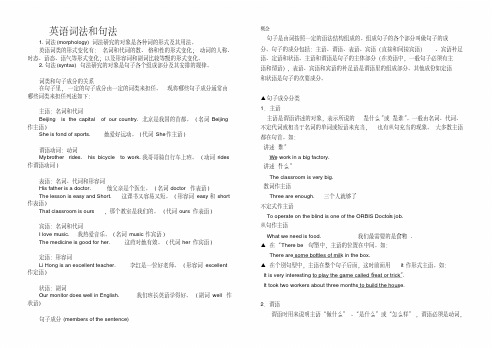
英语词法和句法1.词法(morphology)词法研究的对象是各种词的形式及其用法。
英语词类的形式变化有:名词和代词的数、格和性的形式变化;动词的人称、时态、语态、语气等形式变化;以及形容词和副词比较等级的形式变化。
2.句法(syntax)句法研究的对象是句子各个组成部分及其安排的规律。
词类和句子成分的关系在句子里,一定的句子成分由一定的词类来担任。
现将哪些句子成分通常由哪些词类来担任列述如下:主语:名词和代词Beijing is the capital of our country.北京是我国的首都。
(名词Beijing 作主语)She is fond of sports.她爱好运动。
(代词She作主语)谓语动词:动词My b rother rides. his bicycle to work.我哥哥骑自行车上班。
(动词rides 作谓语动词)表语:名词、代词和形容词His father is a doctor.他父亲是个医生。
(名词doctor作表语)The lesson is easy and Short.这课书又容易又短。
(形容词easy和short 作表语)That classroom is ours,那个教室是我们的。
(代词ours作表语)宾语:名词和代词I love music.我热爱音乐。
(名词music作宾语)The medicine is good for her.这药对她有效。
(代词her作宾语)定语:形容词Li Hong is an excellent teacher.李红是一位好老师。
(形容词excellent 作定语)状语:副词Our monitor does well in English.我们班长英语学得好。
(副词well作状语)句子成分(members of the sentence) 概念句子是由词按照一定的语法结构组成的。
组成句子的各个部分叫做句子的成分。
句子的成分包括:主语、谓语、表语、宾语(直接和间接宾语)、宾语补足语、定语和状语。
句法结构梳理
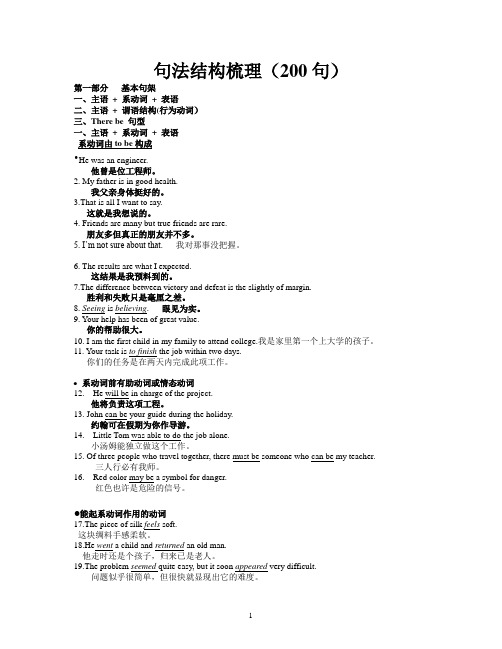
句法结构梳理(200句)第一部分基本句架一、主语+ 系动词+ 表语二、主语+ 谓语结构(行为动词)三、There be 句型一、主语+ 系动词+ 表语系动词由to be构成•He was an engineer.他曾是位工程师。
2. My father is in good health.我父亲身体挺好的。
3.That is all I want to say.这就是我想说的。
4. Friends are many but true friends are rare.朋友多但真正的朋友并不多。
5. I’m not sure about that. 我对那事没把握。
6. The results are what I expected.这结果是我预料到的。
7.The difference between victory and defeat is the slightly of margin.胜利和失败只是毫厘之差。
8. Seeing is believing. 眼见为实。
9. Your help has been of great value.你的帮助很大。
10. I am the first child in my family to attend college.我是家里第一个上大学的孩子。
11. Your task is to finish the job within two days.你们的任务是在两天内完成此项工作。
∙系动词前有助动词或情态动词12. He will be in charge of the project.他将负责这项工程。
13. John can be your guide during the holiday.约翰可在假期为你作导游。
14. Little Tom was able to do the job alone.小汤姆能独立做这个工作。
15. Of three people who travel together, there must be someone who can be my teacher.三人行必有我师。
句法全部知识点总结

句法全部知识点总结一、基本句型1. 主谓结构主谓结构是最简单的句子结构,由主语和谓语构成,如:He reads.2. 主谓宾结构主谓宾结构由主语、谓语和宾语构成,如:She eats an apple.3. 主谓宾宾结构主谓宾宾结构由主语、谓语、宾语和宾语构成,如:Tom gave Mary a book.4. 主系表结构主系表结构由主语、系动词和表语构成,如:She is a teacher.5. 主系表宾结构主系表宾结构由主语、系动词、表语和宾语构成,如:They made me their leader.6. 否定句否定句在句子之前加上否定词not,如:She does not like him.7. 疑问句疑问句是用来询问信息的句子,有两种类型:一种是用疑问词开头的特殊疑问句,另一种是用助动词开头的一般疑问句,如:What are you doing? Are you coming?8. 感叹句感叹句用来表达惊讶、喜悦等情感,如:What a beautiful girl she is!二、从句1. 名词性从句名词性从句有三种:主语从句、宾语从句和表语从句。
主语从句用作主语,宾语从句用作宾语,表语从句用作表语。
如:What he said is true.2. 定语从句定语从句用来修饰名词,如:The man who is standing there is my teacher.3. 状语从句状语从句用来表示时间、原因、条件、结果等信息,如:If it rains, we won't go out.三、倒装句1. 完全倒装完全倒装是指将助动词、情态动词或系动词提到句首,如:Here comes the bus.2. 部分倒装部分倒装是指将助动词、情态动词或系动词提到句首,如:Not only did he come, but also he brought gifts.四、虚拟语气1. 虚拟条件句虚拟条件句用来表示假设、愿望等虚拟情况,如:If I were you, I would go.2. 虚拟语气在宾语从句中的应用在宾语从句中,应用虚拟语气表示不太可能发生的情况,如:He suggested that she study harder.以上就是英语语法中的句法知识点总结,句法知识是英语学习的基础,掌握好这些知识点可以帮助我们更加准确地理解和表达信息。
英语句法结构介绍

英文的句法结构英语是一门结构性语言。
一个学英语之人在使用英语时必须具备三个意识,即词形变化意识,时态和语态意识和句子结构意识。
如果我们具备以上三意识,在平时有意识地进行必要的训练,在短短几个月中完全可以大幅度地提高自己的英语水平的。
英文的句子结构可分两大类:基本结构和特殊结构。
英文句子的基本结构1.简单句的五大基本句型。
英文句子是以简单句为主体。
并列句是由并列连接词连接的两个简单句;主从复合句是由一个从属连接词连接的从句和一个独立的简单句构成的。
英文简单句的五种基本句型。
(1)主语+ 谓语。
此句型的谓语动词是不及物动词,常带状语。
例如:The fruit shop has closed.They have been singing and dancing for two hours.The plane will take off soon.They will fly to London.(2)主语+ 系动词+ 表语。
此句型结构中的谓语动词是系动词,后接表语。
常用的系动词除be外,还有become, look, seem, appear, get, feel, grow, turn, remain, come, hold, keep, stand, stay(保持),smell, sound, taste等等。
例如:The motor is out of order.Her mother has fallen ill.The weather is getting quite hot.The roses smell sweet.Silk feels soft and smooth.The plan sound perfect.(3)主语+ 谓语+ 宾语此句型中的谓语动词是及物动词,后面跟宾语。
例如:He studies English.The teacher corrected her poor pronunciation more than once.We should help the disabled.(4)主语+ 谓语+ 间接宾语+ 直接宾语。
英语句法结构

He is saving up to buy a mobile phone.
A bright little boy with rosy cheeks put three bottles of milk quietly on my doorstep before seven o’clock. He worked like a madman in the garden on Saturday. The young girl with long black hair seems to be very happy.
主语、动词(不及物动词、及物动词、双宾动词、系动词、 宾补动词)、宾语及补语可以称为基本句子成分。
完整的句子一般至少包含2个基本成分,至多4个基本成分。
Noun / Pronoun / The + adj V-ing / Clause / Infinitive Vi
宾语
noun 谓 宾语(直) 宾语(间) adj. / adv. Vt 语 宾语 宾补 infinitive V-ing 表语 V-l V-ed noun etc. Noun / Pronoun pronoun The + adj adj. / adv. be / feel / seem / look V-ing / Clause infinitive appear / stand / lie Infinitive V-ing / V-ed become /get / grow / turn clause go / come / remain/ keep etc. taste / smell etc.
附属成分
基本成分的修饰语。可以是: • 定语:即用来修饰名词的单词、短语或从句 • 状语:即用来修饰名词或代词以外的词的单词、 短语或从rd a hospital nearby. She likes oranges imported from the USA. John gave Mary many books,which are full of illustrations. Have you seen the book on the desk? The boy playing over there is my brother. People there like sports.
- 1、下载文档前请自行甄别文档内容的完整性,平台不提供额外的编辑、内容补充、找答案等附加服务。
- 2、"仅部分预览"的文档,不可在线预览部分如存在完整性等问题,可反馈申请退款(可完整预览的文档不适用该条件!)。
- 3、如文档侵犯您的权益,请联系客服反馈,我们会尽快为您处理(人工客服工作时间:9:00-18:30)。
At last they gor the telegram they had been expecting.
最后他们收到了他们一直盼望的电报。
三、时态强化练习
1. . My dictionary __________, I have looked for it everywhere but still_________ it.
A. have been staying B. have stayed
C. shall stay D. will have stayed
5. You don’t need to describe her. I ______________ her several times.
今年秋天他们要出版曹禺剧作的一个新译本。
3、一般将来时
一般将来时由助动词shall (will)加动词原形构成。它表示将要发生的动作或情况。
They will sit the post-graduate examinations next autumn.明年秋他们要参加工硕考试。
By the next month, I'll have finished my task. 到下个月,我将完成任务。
They will have hit the year’s target by the end of October.
到十月底他们就可完成全年的指标了。
10、现在完成进行时
自我们上次见面以来,她就一直忙着筹备那个展览。
11、过去完成进行时
过去完成进行时由had been加现在分词构成,表示过去某一时刻之前开始的动作或状态一直延续到过去某一时刻。例如:
It had been raining cats and dogs for over a week and the downpour had caused landslides in many places. 倾盆大雨下了一周,在许多地区引发了山崩。
现在完成进行时由have(has)been加动词的现在分词构成,表示发生在过去的某个动作延续到现在或刚刚完成,或许还要继续延续。这种时态侧重于这个动作的连续性,或者说不间断性。例如:
I’ve been waiting for you for the whole morning. 整个上午我一直在等你。
The teacher will not let me go home before I have finished my homework.
老师要我做完作业才能回家。
4、一般过去时
一般过去时由动词过去式表示,动词be 根据人称有was和were两个词形,规则动词在词尾加-d-或ed;其他动词参阅不规则动词变化表, 该时态主要表示过去某时发生的动作或情况。
上大学前他一点英语没学过。
8、一般过去将来时
一般过去将来时由助动词would加动词原形构成,主要表示从过去某一时间角度看以后将要发生的动作。含这个时态的句子常带一个表示“过去某个时间点”的状语。这个状语或是一个短语,或是一个句子。这个时态常用于:宾语从句或间接引语中。例如:
The Yangtze rises in Qinghai. 长江发源于青海。
Actions speak louder than words. 行动胜于言辞。
We have friends all over the world. 我们的朋友遍天下。
2、现在进行时
现在进行时是由助动词be加现在分词构成的。主要表示现在或现时刻这一阶段正在进行的动作,有时候还用来表示一个最近按计划或安排要进行的动作。
将来shall do
will shall (will) be doing shall (will) have doneshall (will) have been doing
过去将来should (would) doshould (would) be doingshould (would)
When I thought about it, I wondered what their reaction would be.
当我考虑这件事时,我想知道他们的反应是什么。
She told me that she would go on trip to Europe the next day.
她告诉我,她第二天要去欧洲旅行。
Whenever he had time, he would help his mother with some housework.
无论他什么时间有空,他总是帮他妈妈干点家务活。
No matter how difficult the work was , he would keep on doing it until he accomplished it . 不管工作有多难,他总会坚持不懈地把它干完。
How are things getting on with you? 工作进行的怎么样?
Someone is asking for you on the phone. 有人找你接电话。
They are publishing a new version of the playscript by Taso Yu this autumn.
一般时态进e (am, is are ) doinghas doing
havehas been doing
have
过去did be (was, were) doinghad donehad been doing
A. has lost, don’t find B. is missing, don’t find
C. has lost, haven’t found D. is missing, haven’t found.
2. Mary ____________ a dress when she cut her finger.
C. will not give; succeed D. would not give; will succeed
4. By the time he arrives in Beijing tomorrow, we __________ here for two days.
5、现在完成时
现在完成时是由助动词have和has加过去分词构成的。主要表示此刻以前曾经发生的动作或情况。如:
Grain output has greatly increased in the past few years. 这几年粮食产量有了很大增长。
The area has suffered from disastrous floods throughout its history.
have done should (would) have been doing
下面根据这些时态常用的程度不同分别说明它们的用法。
二、各时态详解
1、一般现在时
一般现在时主要由动词原形表示,但第三人称单数后要加词尾-s,另外be 和have要根据人称的变化使用特殊的形式。一般现在时主要表示经常性的动作或存在的状态,还可用来表示普遍真理。
It has been raining for three days. 雨连续下了三天。
Where have you been? 你去哪儿啦?
She has been busy preparing the exhibition since we met last time.
一、概述
在作谓语的动词用来表示动作(或情况、状态)发生时间的各种形式称为时 态。由于英语属于曲折变化的语言,其动词时态的变化要通过词的曲折词形变化来体现的,因而也就有了现在式、过去式、过去分词式三个基本词形。英语中根据说话的时间不同有时和体的不同,主要有十六这十二种时态可以列表如下:
被过滤广告
A. made B. is making C. was making D. makes
3. He said he________me a present unless I_______ in doing the experiment.
A. had not given; had not succeeded B. would not give; succeed
到目前为止我们共种了一万多棵苹果树。
I saw him a minute ago. 我前一会还见到他的。
6、过去进行时
过去进行时是由助动词be的过去式加上现在分词构成的,主要表示过去某个时刻正在进行的动作。
At that time she was working as an assistant in a physics labatory.
It’s a pity that you did not go to the movie. 很遗憾你没有去看那部电影。
Many people died in the tsunami that took place in Thailand.
很多人在泰国的那次海啸中遇难丧生。
那时她在一家物理实验室做助手。
They took us to see the chemical fibre mill that they were building.
他们带我们去参观了他们正在修建的化纤厂。
7、过去完成时
过去完成时由助动词had加动词的过去分词构成,主要表示过去某时刻前业已完成的动作或存在的状态,其实就是指过去的过去。使用时往往要要在从句中或有一个明确的过去时间状语。
这个地区历史上一直遭受水患之苦。
注意:过去时和现在完成时的区别:
现完成时的基本特点是它和现在有密切的联系,或是指迄今为止这一段时间的情况,或是过去发生的事对现在造成的影响或结果等。而过去时主要强调过去某时刻所发生的动作或情况,与现在没有任何联系。如:
